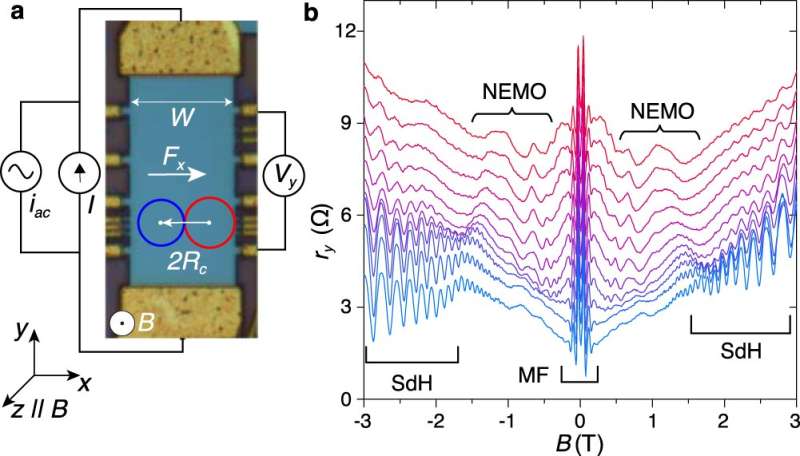
A team of researchers has revealed that sonic boom and Doppler-shifted sound waves can be created in a graphene transistor, giving new insights into this world-famous material and its potential for use in nanoscale electronic technologies.
When a police car speeds towards you and passes by with its siren blaring, you can hear a distinct change in the frequency of the siren’s noise. This is the Doppler effect. When a jet aircraft’s speed exceeds the speed of sound (about 760 mph), the pressure it exerts upon the air produces a shock wave which can be heard as a loud supersonic boom or thunderclap; this is the Mach effect.
Scientists from Loughborough, Nottingham, Manchester, Lancaster and Kansas universities have discovered that a quantum mechanical version of these phenomena occurs in an electronic transistor made from high purity graphene. Their new publication, Graphene’s non-equilibrium fermions reveal Doppler-shifted magnetophonon resonances accompanied by Mach supersonic and Landau velocity effects, has been published today in Nature Communications.
Graphene is over 100 times stronger than steel while being extremely light, over 100 times more conductive than silicon, and has the lowest electrical resistivity at room temperature of all known materials. These properties make graphene well suited for a range of applications, including coatings to improve touch screens in phones and tablets and to enhance the speed of electronic circuits.
The research team used strong electric and magnetic fields to accelerate a stream of electrons in an atomically-thin graphene monolayer composed of a hexagonal lattice of carbon atoms.
At a sufficiently high current density, equivalent to around 100 billion amps per square meter passing through the single atomic layer of carbon, the electron stream reaches a speed of 14 kilometers per second (around 30,000 mph) and starts to shake the carbon atoms, thus emitting quantised bundles of sound energy called acoustic phonons. This phonon emission is detected as a resonant increase in the electrical resistance of the transistor; a supersonic boom is observed in graphene.
The researchers also observed a quantum mechanical analog of the Doppler effect at lower currents when energetic electrons jump between quantised cyclotron orbits and emit acoustic phonons with a Doppler-like up-shift or down-shift of their frequencies, depending on the direction of the sound waves relative to that of the speeding electrons.
By cooling their graphene transistor to liquid helium temperature, the team detected a third phenomenon in which the electrons interact with each other through their electrical charge and make “phononless” jumps between quantised energy levels at a critical speed, the so-called Landau velocity.
Loughborough’s Dr. Mark Greenway, one of the authors of the paper, said: “It is fantastic to observe all of these effects simultaneously in a graphene monolayer. It is due to graphene’s excellent electronic properties that allow us to investigate these out-of-equilibrium quantum processes in detail and understand how electrons in graphene, accelerated by a strong electric field, scatter and lose their energy. The Landau velocity is a quantum property of superconductors and superfluid helium. So it was particularly exciting to detect a similar effect in the dissipative resonant magnetoresistance of graphene.”
The devices were fabricated at the National Graphene Institute, University of Manchester.
Dr. Piranavan Kumaravadivel, who led device design and development notes, “the large size and high quality of our devices are key for observing these phenomena. Our devices are sufficiently large and pure that electrons interact almost exclusively with phonons and other electrons. We expect that these results will inspire similar studies of non-equilibrium phenomena in other 2D materials. Our measurements also demonstrate that high-quality graphene layers can carry very high continuous current densities which approach those achievable in superconductors. High purity graphene transistors could find future applications in nanoscale power electronic technologies.”
More information:
M. T. Greenaway et al, Graphene’s non-equilibrium fermions reveal Doppler-shifted magnetophonon resonances accompanied by Mach supersonic and Landau velocity effects, Nature Communications (2021). DOI: 10.1038/s41467-021-26663-4
Journal information:Nature Communications
Provided by
Loughborough University

READ MORE
Research suggests how turbulence can be used to generate patterns
Left image: Normal turbulence is a random mix of eddies. Right image: Patterns with a [...]
Social Contact Helps Beneficial Gut Bacteria Spread
Chimpanzees engage in social grooming in Gombe National Park. Fiona Rogers/Corbis When your co-worker is [...]
Nanobiotics: New machine learning model predicts how nanoparticles interact with proteins
The model predicted how a zinc oxide nanopyramid interrupts a protein that contributes to metabolism [...]
Artificial cells produce parts of viruses for safe studies
Fluorescent image of artificial cells on a chip. The differences in genetic composition between cells [...]
Temporal-spatial order property of hollow multishelled structures enables sequential drug release
Schematic illustration of the sequential drug release by Hollow multishelled structure. Credit: Yang Nailiang Hollow [...]
Sorry Pluto, You Still Aren’t a Planet
This composite image features Pluto and its largest moon Charon in enhanced color. NASA/Johns Hopkins [...]
Chairman Mao Zedong Used Death and Destruction to Create a New China
Mao Zedong, aka Chairman Mao, founded the People’s Republic of China in 1949 and ruled [...]
Controlling magnetization direction of magnetite at room temperature
After applying an external voltage, lithium ions flow through the reduction-oxidation transistor and reach the [...]